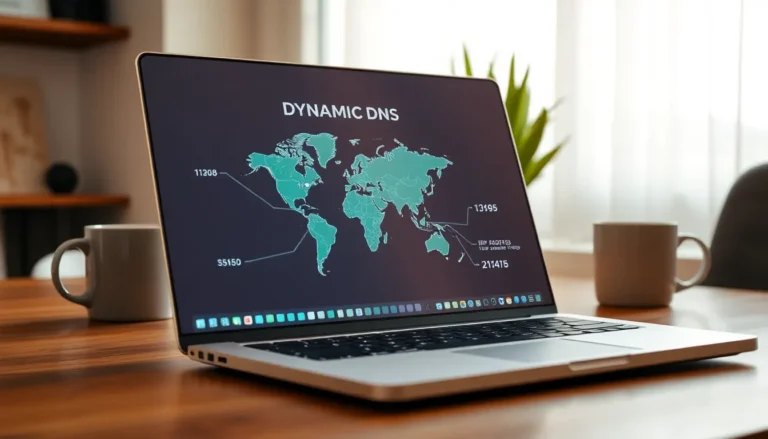Table of Contents
ToggleIn a world where apps are as common as coffee shops, integrations and APIs are the unsung heroes making everything work seamlessly. Imagine trying to brew a perfect cup of coffee without a coffee maker—frustrating, right? That’s what it feels like when businesses lack effective integrations. APIs act as the magic glue, connecting various software and services, ensuring they play nicely together.
Overview of Integrations and APIs
Integrations and APIs serve critical functions in connecting systems and enhancing operational efficiency. They facilitate seamless interactions among various software applications, enabling businesses to thrive in a competitive digital landscape.
Definition of Integrations
Integrations refer to the processes that enable different software systems to communicate with each other. This process streamlines operations and ensures data flow between platforms. Businesses leverage integrations to enhance workflows, automate tasks, and eliminate data silos. Effective integrations can occur via several methods, including direct connections, middleware solutions, and cloud services. Each method serves a specific need, tailoring the approach to unique requirements. Through integrations, companies maximize existing resources while improving productivity.
Definition of APIs
APIs, or application programming interfaces, act as the bridges that allow software applications to interact. They define the methods and data formats that applications can use for communication. APIs streamline development by providing standard protocols, which helps reduce coding time. Various types of APIs exist, including public, private, and partner APIs, each serving different purposes and user bases. Businesses rely on APIs to enable new functionalities, access external services, and enhance user experiences. By utilizing APIs effectively, companies can innovate quickly and respond to market changes with agility.
Importance of Integrations and APIs

Integrations and APIs play a crucial role in today’s digital landscape, enabling seamless interaction between software and services. They drive efficiency, innovation, and overall business success.
Enhancing Connectivity
Connectivity stands at the forefront of modern business operations. Integrations allow diverse systems to communicate, creating a cohesive network that enhances collaboration. APIs facilitate this interaction by providing standardized methods for data exchange, leading to streamlined processes. Different teams can share information more easily, breaking down barriers that typically isolate departments. Enhanced connectivity not only improves workflow but also fosters innovation by allowing organizations to leverage external resources and services.
Improving Efficiency
Efficiency gains significantly improve organizational performance. Integrations reduce manual data entry, minimizing errors that can arise from repeated tasks. APIs contribute to this efficiency by automating interactions between systems, freeing up employees to focus on higher-value activities. Redundant processes diminish, and organizations experience smoother operations. As a result, businesses can respond more rapidly to market changes, giving them a competitive edge. Overall, enhanced efficiency stems from the strategic use of integrations and APIs, driving growth and productivity in today’s fast-paced environment.
Types of Integrations and APIs
Different types of integrations and APIs play distinct roles in enhancing connectivity. Understanding these categories empowers businesses to choose the right tools for their needs.
Open APIs
Open APIs, also known as external or public APIs, allow third-party developers access to software applications. These APIs enable the integration of various services, fostering innovation and collaboration. Companies often use open APIs to extend functionality and reach new audiences. For instance, social media platforms like Twitter provide open APIs for developers to build applications that interact with their services. This access facilitates a wide range of applications, from data analytics tools to enhanced user experiences. Open APIs contribute significantly to a thriving ecosystem, where external developers can create unique solutions.
Private APIs
Private APIs, or internal APIs, operate within a company’s infrastructure. These APIs connect internal systems and streamline operations without external access. For instance, a company may utilize private APIs to integrate its customer relationship management system with its inventory management software. This integration enhances data flow and reduces redundancy. Private APIs optimize internal processes, ensuring that teams work effectively and access information seamlessly. By controlling data flow within the organization, businesses can maintain security while improving efficiency.
Composite APIs
Composite APIs allow multiple endpoints to be invoked in a single call. By enabling the retrieval of data from various sources, these APIs simplify interactions for developers. For instance, a composite API might aggregate data from different services, such as fetching user profiles, photos, and posts from social media platforms simultaneously. This approach minimizes the number of requests needed, speeding up response times and reducing latency. Composite APIs cater to complex applications, providing a streamlined method for combining diverse data into cohesive responses. Businesses benefit from improved performance as they leverage these efficient connections.
Best Practices for Implementing Integrations and APIs
Implementing effective integrations and APIs requires attention to detail and adherence to best practices. Following these guidelines ensures smooth and efficient operations.
Documentation and Standards
Comprehensive documentation plays a crucial role in successful integrations and API usage. Clear guidelines help developers understand the setup and functionality, allowing for easier troubleshooting. Consistent standards in naming conventions, data formats, and error handling enhance clarity across teams. APIs should include clear usage examples and versioning details for seamless updates. Establishing common protocols fosters collaboration among developers and third-party partners. By prioritizing thorough documentation, businesses streamline onboarding and minimize errors during implementation.
Security Measures
Robust security measures are paramount when working with integrations and APIs. Implementing authentication protocols such as OAuth or API keys protects sensitive data from unauthorized access. Regular security audits help identify vulnerabilities and ensure compliance with industry standards. Encrypting data in transit safeguards against potential breaches during information exchange. Limiting access based on user roles enhances data integrity and minimizes risk. Regular updates to security practices maintain a strong defense against evolving threats. By prioritizing these security measures, organizations create a secure environment for their integrations and API ecosystems.
Popular Tools for Integrations and APIs
Various tools enhance the functionality of integrations and APIs in today’s business environment. Recognizing these tools aids organizations in optimizing their digital strategies.
API Management Platforms
API management platforms facilitate the creation, deployment, and oversight of APIs. These platforms provide developers with essential tools for designing, securing, and monitoring APIs. Examples of popular API management platforms include Apigee, AWS API Gateway, and MuleSoft. These solutions enable businesses to manage traffic, gain insights through analytics, and enforce security policies effectively. Moreover, they streamline collaborations between internal teams and third-party developers, enhancing productivity and innovation.
Integration Platforms as a Service (iPaaS)
Integration Platforms as a Service (iPaaS) streamline the process of connecting various applications and data sources. They offer a cloud-based environment for integrating on-premise and cloud applications. Tools like Dell Boomi, Tray.io, and Workato exemplify iPaaS solutions that simplify complex data workflows. Users can easily configure integrations using drag-and-drop interfaces, reducing reliance on manual coding. These platforms enhance scalability and flexibility, accommodating a wide range of integration needs as businesses grow and evolve.
Integrations and APIs are indispensable for businesses navigating the complexities of the digital age. Their ability to streamline operations and foster collaboration can’t be overstated. By effectively utilizing these tools, organizations can enhance efficiency and drive innovation.
Prioritizing best practices in implementation ensures that integrations and APIs function optimally. Comprehensive documentation and robust security measures are key to creating a reliable environment. As businesses continue to evolve, leveraging the right tools will be crucial for maintaining a competitive edge.
Ultimately, successful integration of APIs and systems leads to improved productivity and agility. Companies that embrace these technologies will be better positioned to adapt to market changes and seize new opportunities.







